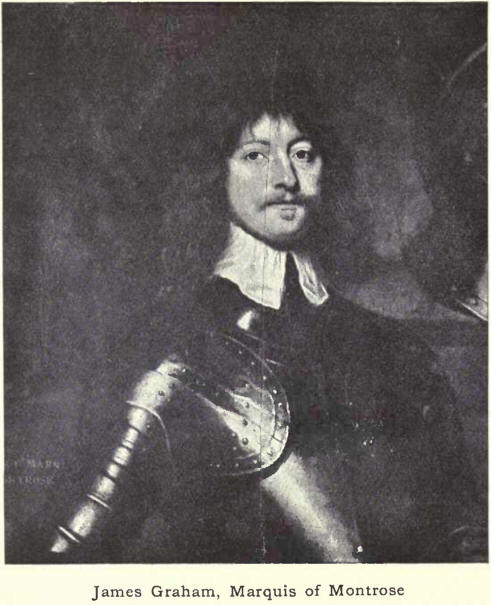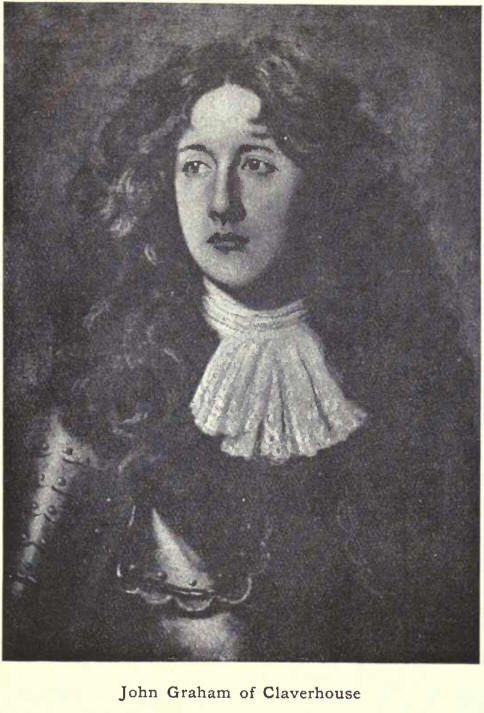|
Numerous Roman
remains, more conspicuous indeed a century ago than they are now,
prove that the Romans visited various parts of Angus. Camps at
Meikleour and Lintrose in Perthshire seem to have been directly
connected with others at Coupar Angus, Cardean, Battle Dykes near
Forfar, and War Dykes north of Brechin; while former traces of a
camp at Cater Milley [quatuor milia\ beside Invergowrie, and an
entire entrenchment at Haerfaulds near Kirkbuddo, point to the
possible existence of another Roman military route between the
Sidlaws and the Tay.
Within a couple of
centuries after the Romans left, Christianity was introduced into
Scotland. Tradition has it that as early as 431 the first church
north of the Tay was founded at Invergowrie. Boniface, a missionary
from Rome, seems to have been there in the seventh century, while in
the eighth, St Drostan, abandoning his bishopric in Donegal, settled
as the apostle of the faith in the wilds of Glenesk. At a still
later period the Culdees established themselves at Brechin.
Forfarshire was one
of the main theatres of the long-continued conflict of the Picts
with the Scots on the one hand and with the Angles of Northumbria on
the other. Historians are agreed in identifying the site of the
battle of Nechtan’s Mere with Dunnichen in Forfarshire. For long the
Angles had assumed possession of Pictland, but on that battlefield
their king, Egfrith, was decisively repulsed, and the limits of
Northumbria were pushed south to the Tweed.
But the Picts were
destined to find a more formidable enemy in the Scots. On the
conflict with them as well as on the civil wars amongst the Picts
themselves, history sheds an uncertain light. That the Scots were
the ultimate victors in their struggle with the Picts is certified
by the fact that in 844 both accepted Kenneth MacAlpin as their
king; but it is clear from the records of such engagements as the
battle of Liff, that their victory was by no means assured from the
first. On that occasion, Alpin, a Scottish king, whose headquarters
had been at Dundee, was defeated and slain by the Picts at Pitalpin
(i.e. grave of Alpin) near Camperdown.
Angus suffered with
other districts from the raids of the Vikings. In 980 they are said
to have taken the town and castle of Montrose. In 1012 they appear
to have landed in three bands at Montrose, Lunan Bay, and near
Carnoustie. They succeeded in burning Brechin, but met with signal
defeat at Barry and Aberlemno. Near the former place, in what is
sometimes known as the Battle of Panbride, Malcolm II won a great
victory over Camus, general of King Sweno of Norway. This leader is
said to have been buried at Camuston, where an abnormally large
skeleton with part of the skull cut away was reported to have been
found. A rude clay urn and a bracelet of gold preserved at Brechin
Castle are regarded as relics of this incursion. It is at least
certain that in no part of Angus have so many traces of ancient
sepulture been found as near Aberlemno and Carnoustie. Numerous
traces of the Vikings exist near Lunan and Inverkeillor.
The eleventh,
twelfth, and early thirteenth centuries, though comparatively
obscure, were a momentous era for all Scotland and are especially
noteworthy in the history of Forfarshire. The county was then often
favoured by the presence of royalty, and the county-town attained an
eminence it was not destined to hold permanently. The names of
Malcolm II, Malcolm Canmore and Queen Margaret, David I, William the
Lion, and Alexander II, are often closely associated with Angus in
such matters as the building of fortalices, the holding of royal
councils, the founding of ecclesiastical institutions, and die
granting of charters and trading privileges to towns. These also are
the centuries during which manly aristocratic families settled in
this part of the country.
Angus figures
prominently in the War of Independence. In the years 1295—7 Dundee
changed hands no fewer than three times, Wallace and Scrimgeour, who
acted fori him in his absence, taking it from the English, and
Morton and Edward himself recapturing it from the Scots. At
Stracathro in 1296 John Baliol appeared, stripped of his kingly
ornaments, before Edward, and formally surrendered all claims to the
kingdom of Scotland. In 1306 the National Council met in Dundee and
declared Bruce rightful king. Six years later his brother took
Dundee from the English. Five times between 1320 and 1328 Bruce took
up his quarters at the Abbot’s house in Arbroath; while parliament
met in the abbey and issued the Declaration of the Independence of
Scotland, and their remonstrance against the excommunication of
Kina; Robert by Pope John XXII. During the minority of David II, his
regent, Sir Andrew Murray, gained a notable victory at Panmure over
Lord Montfort commanding an army for Edward III.
The Grampians formed
the natural boundary line between Celtic and anglicised Scotland,
and Angus, lying as it did just within the borders of the latter,
had to bear the brunt of many an invasion from the north. About
11392 the son of the Wolf of Badenocb made his appearance amongst
the Braes of Angus at the head of a band of Highland caterans, and
wasted the country. Walter Ogilvy, the sheriff of the county,
defeated him with great slaughter.
In those days family
feuds were common. Ogilvy of Inverquharity had superseded the Master
of Crawford as justiciar in the regality of the Abbey of Arbroath.
This caused a fierce feud between the Lindsays and the Ogilvys; and
in the battle of Arbroath, in which both sides suffered severely,
the latter were defeated. Inverquharity is said to have been
smothered in the Castle of Finhaven.
A mysterious affair
in the reign of James V was the execution of Lady Glamis, sister of
the Earl of Angus. Having “conspired and imagined the destruction of
the most noble person of our most serene lord the king by poison,”
so ran the charge against her, she was burned to death upon the
Castle Hill, Edinburgh, “with great commiseration of the people in
regard of her noble blood, being in the prime of her life, of a
singular beauty, and suffering, although a woman, with a manlike
courage.”
In the Reformation
Forfarshire played an important part. Indeed, Dundee was the first
Scottish burgh to declare for the reformed faith, and the
inhabitants signalised the new departure in 1543 by destroying the
houses of the Black and the Grey Friars.
With the rest of the
county, Forfarshire suffered alike from English and French attempts
at domination during Queen Mary’s minority. Dundee was taken and
fired by the English soon after the battle of Pinkie. Broughty
Castle, which the English seized about the same time, was recaptured
by the^Scots and the French in 1549.
The next decade is
marked by the ascendency of the Lords of the Congregation and their
struggle with the queen-regent, Mary of Guise. Dundee was for some
time their headquarters. They seized and fortified Broughty Castle.

When James VI left
the kingdom to succeed Queen Elizabeth, deadly feuds raged amongst
the nobles. In Forfarshire Ogilvys and Lindsays carried on their
ancient family animosities. These feuds were not always confined to
neighbouring families. The burning of the “Bonnie Hoose o’ Airlie”
was an act of vengeance on the Ogilvys carried out in 1640 by the
far-stretched arm of Argyle.
During the campaign
of 1644-1645, the Marquis of Montrose did not spare his native
shire. Covenanters and Royalists fought in the town of Montrose; and
next year the Marquis stormed and pillaged Dundee, which supported
the Covenanters.
Between 1645 and 1648
Forfarshire suffered along with the rest of the country during a
visitation of the plague which is said to have carried off nearly
half of the inhabitants. The attempt made by Charles II, in 1650, to
escape from the Covenanters, which is known in history as the
“Start,” had its scene mainly in Angus. Taking flight from Perth, he
rode by way of Dudhope, Auchter-house, and Cortachy to Clova, where
he was overtaken by his pursuers “in a nasty room above a mat of
sedges and rushes, overwearied and very fearful.”
Next year General
Monk captured and sacked Dundee. In 1689 Forfarshire was the scene
of several of Claverhouse’s movements and operations; and in 1715 it
was strongly Jacobite. The magistrates of Dundee being for James,
the Old Pretender, although most of the citizens were Hanoverian,
Graham of Duntrune proclaimed him king there. On January 16, 1716,
James, accompanied by his lieutenant, the Earl of Mar, entered
Dundee; and, on the collapse of the rebellion, he sailed from
Montrose. In 1745 there was strife at Montrose between the Jacobites
and the Royalists. Dundee was seized and held for five months for
Prince Charles. After Culloden many of the Jacobites found refuge in
Glenesk; and Dundee being recovered for the Royalists, Cumberland
entered the city and received in a golden casket a free burgess
ticket.

Towards the close of
the eighteenth century the bread riots of “the Meal Mob” occurred in
Dundee ; and a celebrated local incident was the planting in the
High Street of the “Tree of Liberty,” a piece of work so distasteful
to the provost that he had the tree uprooted and thrown into a
cellar, whence it was afterwards removed to a garden in the west end
of the city. As might be expected the French Revolution was not
without its effects in a district so radical. Political discussion
was rife and the authorities put it down with a high hand. George
Mealmaker’s address to the people of Scotland on the subject of
reform was edited by a Dundee clergyman, Thomas Fysche Palmer, who
paid for his fearless efforts in the cause of liberty by seven
years’ transportation to Australia, in which he was accompanied
voluntarily by James Ellis, an ardent admirer of his action. In 1816
Parliamentary reform was actively taken up by Dundonians, and is
associated with the names of Rintoul, Mudie, and Kinloch. Local
interest in the subject is memorialised in street names, like Reform
Street. |

